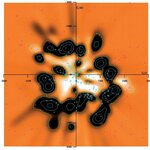Space

Yesterday a press release about a new interstellar medium map that has been published (PDF) in Astronomy and Astrophysics caught my eye. A French-American team of astronomers, combining previously published results with new data, mostly gathered through observations from the European Southern Observatory in Chile, have presented high spectral resolution measurements of the absorption of calcium and sodium by the interstellar gas in the Sun's local area.
Astronomers study the interstellar medium, to better understand how stars exchange matter with their ambient surroundings as they…
The Visible and Infrared Survey Telescope for Astronomy (VISTA), the latest addition to ESO's Paranal Observatory (eso0949), has captured a dramatic new image of the Orion Nebula. The New telescope is the largest survey telescope in the world and is dedicated to mapping the sky at infrared wavelengths.
As in the many visible light pictures of this object, the new wide field VISTA image shows the familiar bat-like form of the nebula in the center of the picture as well as the fascinating surrounding area. At the very heart of this region lie the four bright stars forming the Trapezium, a group…
For the first time, a team of astronomers has completed a demographic census of galaxy types at two different points in the Universe's history — in effect, creating two Hubble sequences — that help explain how galaxies form. The survey of 116 local galaxies and 148 distant galaxies indicates that the Hubble sequence six billion years ago was very different from the one that astronomers see today.
"Six billion years ago, there were many more peculiar galaxies than now — a very surprising result," says Rodney Delgado-Serrano, lead author of the paper recently published in Astronomy and…
The starburst region NGC 3603 is a cosmic factory where stars form frantically from the nebula's extended clouds of gas and dust. Located 22 000 light-years away from the Sun, it is the closest region of this kind known in our galaxy, providing astronomers with a local test bed for studying intense star formation processes, very common in other galaxies, but hard to observe in detail because of their great distance from us.
The nebula owes its shape to the intense light and winds coming from the young, massive stars which lift the curtains of gas and clouds revealing a multitude of glowing…

Astronomers have discovered another black hole with a mass over fifteen times that of the Sun, one of only three such objects found so far. The newly announced black hole lies in a spiral galaxy called NGC 300, six million light-years from Earth.
"This is the most distant stellar-mass black hole ever weighed, and it's the first one we've seen outside our own galactic neighborhood, the Local Group," says Paul Crowther, Professor of Astrophysics at the University of Sheffield and lead author of the paper appearing in Monthly Notices of the Royal Astronomical Society.
The black hole's curious…

Take 2 minutes with Canadian astronaut Chris Hadfield and you too will know how to pee in space. And the origins of shooting stars. He starts with "when you go to the bathroom on Earth, you are relying on gravity, pretty heavily... imagine if you were halfway done and someone shut off the gravity, it would be a mess..." and it just gets better from there. You'll never look at the sky the same way again.
(Video also available at http://offside.video.ca/video.php?id=27 and http://www.youtube.com/watch?gl=CA&hl=en&v=xwe0-Pd-txI)
Chris is a great speaker and I…

Scientific Clogging
A recent story about NASA's water recycling system is clogging Google search results. Apparently, excess calcium in astro-urine is clogging the International Space Station's recycling system.
Engineers trouble-shooting a problem with the station's $250 million water recycling system, which processes urine into clean water for drinking, believe the cause is a high concentration of calcium in the astronauts' urine, which clogs the system...."We've learned a lot more about urine than we ever needed or wanted to know -- some of us anyway," said station flight director…

A doctor's office in nearby Virginia, just one state down from me, got clobbered by a 'mango-sized' meteorite this week. Where others see disaster, I see envy. My envy. My favorite writeup is from The Register, because they have wit and write everything like a TV soap:
Nobody was hurt in the meteor strike, and the pieces of interplanetary
debris were subsequently identified as being extraterrestrial by a
geologist, fortuitously married to the doctors' receptionist....Dr Linda Welzenbach of the Smithsonian - evidently a woman with an
encyclopaedic knowledge of asteroid strikes in…

In a recently released report the National Research Council lays out several options NASA could pursue in order to detect more near-Earth objects (NEOs) – asteroids and comets that could pose a hazard if they cross Earth's orbit. While impacts by large NEOs are rare, a single impact could inflict extreme damage, raising the classic problem of how to confront a possibility that is both very rare and very important.
Far more likely are those impacts that cause only moderate damage and few fatalities. Conducting surveys for NEOs and detailed studies of ways to mitigate collisions is best…

An international team of astronomers has viewed two distinct "tails" found on a long tail of gas that is believed to be forming stars where few stars have been formed before. The new observation was made by the Chandra X-ray Observatory and is detailed in a paper published this month in the Astrophysical Journal.
This gas tail was originally spotted by astronomers three years ago using a multitude of telescopes, including NASA's Chandra X-ray Observatory and the Southern Astrophysical Research telescope, a Chilean-based observatory in which MSU is one of the partners. The new observations…